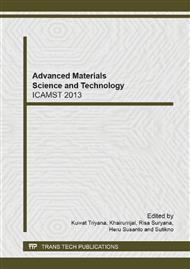p.672
p.676
p.681
p.687
p.695
p.701
p.706
p.710
p.714
Weld Defect Classification in Radiographic Film Using Statistical Texture and Support Vector Machine
Abstract:
Weld defect identification requires radiographic operator experience, so the interpretation of weld defect type could potentially bring subjectivity and human error factor. This paper proposes Statistical Texture and Support Vector Machine method for weld defect type classification in radiographic film. Digital image processing technique applied in this paper implements noise reduction using median filter, contrast stretching, and image sharpening using Laplacian filter. Statistical method feature extraction based on image histogram was proposed for describing weld defects texture characteristic of a radiographic film digital image. Multiclass Support Vector Machine (SVM) algorithm was used to perform classification of weld defects type. The result of classification testing shows that the proposed method can classify 83.3% correctly from 60 testing data of weld defects radiographic films.
Info:
Periodical:
Pages:
695-700
Citation:
Online since:
February 2014
Authors:
Price:
Сopyright:
© 2014 Trans Tech Publications Ltd. All Rights Reserved
Share:
Citation:


